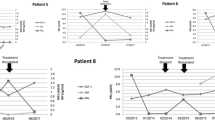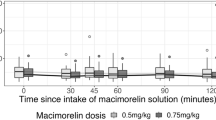Abstract
Aim of the present study was to verify the maximal secretory capacity of somatotrope cells in patients with pathological hyperprolactinemia (HPRL) comparing it with that in normal age-matched women (NW). To this goal in 12 HPRL normal weight patients (age 28.6±2.6 yr, BMI 23.1 ±1.1 kg/m2) and 8 NW (27.2±0.8 yr, 22.8±0.8 kg/m2) we studied the GH response to GHRH (1µg/kg iv), GHRH plus arginine (ARG, 0.5 g/kg iv), an amino acid probably acting at the hypothalamic level inhibiting somatostatin release, and Hexarelin (HEX, 2 µg/kg iv), a synthetic hexapeptide belonging to GHRP family, which acts concomitantly at the pituitary and the hypothalamic level. IGF-I levels in HPRL were similar to those in NW (179.2±16.5 µg/l and 218.5±30.8 µg/l). In NW the GH response to GHRH (AUC: 1299.5±186.9 µg.90 min/l) was lower (p<0.02) than those to GHRH+ARG (5252.7±846.3 µg.90 min/l) and HEX (3216.6±462.3 µg.90 min/l) which, in turn, were similar. In HPRL the GH response to GHRH (894.7±242.4 µg.90 min/l) was lower (p<0.03) than that to HEX (1586.5±251.3 µg.90 min/l) and both were lower (p<0.03) than that to GHRH+ARG (4468.8±941.7 µg.90 min/l). In HPRL the GH responses to GHRH and HEX were lower than those that in NW (p<0.03) while that to GHRH+ARG was similar in both groups. These results demonstrate that the somatotrope responsiveness to GHRH and HEX is clearly reduced in patients with pathological hyperprolactinemia. On the other hand, in this condition the GH response to GHRH+ARG is normal. As arginine likely acts via inhibition of hypothalamic somatostatin release, these findings show that the maximal secretory capacity of somatotrope cells in hyperprolactinemia is preserved and indicate that partial refractoriness of somatotrope cells to GHRH and HEX could be due to somatostatinergic hyperactivity.
Similar content being viewed by others
References
Clemmons D.R., Underwood L.E., Ridgway E.C., Kliman B., Van Wyk J.J. Hyperprolactinemia is associated with increased im-munoreactive somatomedin C in hypopituitarism. J. Clin. Endocrinol. Metab. 52: 731, 1981.
Kelly P.A., Djiane J., Postel-Vinay M.C., Edery M.C. The prolactin growth hormone receptor family. Endocr. Rev. 12: 235, 1991.
Ciccarelli E., Grottoli S., Razzore P., Gianotti L., Arvat E., Deghenghi, R., Camanni F., Ghigo E. Hexarelin, a synthetic growth hormone releasing peptide, stimulates prolactin secretion in acromegalic but not in hyperprolactinaemic patients. Clin. Endocrinol. (Oxf.) 44: 67, 1996.
Chang R.J., Keye W.R., Monroe S.E., Jaffe R.B. Prolactin-secreting pituitary adenomas in women. IV. Pituitary function in amenorrhoea associated with normal or abnormal serum prolactin and sellar poly-tomography. J. Clin. Endocrinol. Metab. 46: 459, 1980.
Ghigo E., Arvat E., Muccioli G., Camanni F. Growth hormone (GH)-releasing peptides. Eur. J. Endocrinol 136: 445, 1997.
Scanion M.F., Rodriguez-Arnao M.D., McGregor A.M., Weightmann D.R., Lewis M., Cook D.B., Gomez-Pan A., Hall R. Altered dopaminergic regulation of thyrotropin release in patients with prolactinomas: comparison with other tests of hypothalamic-pituitary function. Clin. Endocrinol. (Oxf.) 14: 133, 1981.
Camanni F., Ciccarelli E., Ghigo E., Müller E.E. Hyperprolactinemia: neuroendocrine and diagnostic aspects. J. Endocrinol. Invest. 12: 653, 1989.
Müller E.E., Nisticò G. Neuroregulation of the anterior pituitary. In: Müller E.E., Nisticò G. (Eds), Brain messangers and the pituitary. Academic Press, San Diego, 1989, p. 404.
Landgraf R., Landgraf-Leurs M.M.C., Weissmann A., Hörl R., von Werder K., Scriba P.C. Prolactin: a diabetogenic hormone. Diabetologia 13: 99, 1977.
Schernthaner G., Prager R., Punzengruber C., Luger A. Severe hyperprolactinemia is associated with decreased insulin binding in vitro and insulin resistance in vivo. Diabetologia 28: 138, 1985.
Maccario M., Grottoli S., Razzore P., Procopio M., Oleandri S.E., Ciccarelli E., Camanni F., Ghigo E. Effects of glucose load and/or arginine on insulin and growth hormone secretion in hyperprolactinemia and obesity. Eur. J. Endocrinol. 135: 205, 1996.
Ghigo E. Neurotransmitter control of growth hormone secretion. Regulation of growth hormone and somatic growth. In: De la Cruz L.F. (Eds), Growth hormone and somatic growth. Excerpta Medica, Amsterdam, 1992, p. 103.
Alba-Roth J., Albrecht Muller A.O., Schopohl J., Von Werder K. Arginine stimulates growth hormone secretion by suppressing endogenous somatostatin secretion. J. Clin. Endocrinol. Metab. 67: 1186, 1988.
Dallabonzana D., Spelta B., Botalla L., Oppizzi G., Silvestrini F., Chiodini P.G., Liuzzi A. Effects of nomifensine on growth hormone and prolactin secretion in normal subjects and in pathological hyperprolactinemia. J. Clin. Endocrinol. Metab. 54: 1125, 1982.
Faglia G., Beck-Peccoz P., Travaglini P., Ambrosi B., Rondena M., Paracchi A., Spada A., Weber G., Bara R., Rouzin A. Functional studies in hyperprolactinemic states. In: Crosignani P.G., Robyn C. (Eds.), Prolactin and human reproduction. Academic Press, London, 1977, p. 225.
Müller E.E., Cavagnini F., Martinez-Campos A., Maraschini C., Giovannini P., Novelli A., De Leo V. Dynamics testing of prolactin and growth hormone secretion in patients with neuroendocrine disorders. Acta Endocrinol. (Copenh.) 107: 155, 1984.
Corpas E., Harman SM., Blackman G. Human growth hormone and human aging. Endocr. Rev. 14: 20, 1993.
Ghigo E., Goffi S., Nicolosi M., Arvat E., Procopio M., Bellone J., Mazza E., Camanni F. Growth hormone (GH) responsiveness to combined administration of arginine and GHRH-releasing hormone does not vary with age in man. J. Clin. Endocrinol. Metab. 71: 1481, 1990.
Ghigo E., Goffi S., Arvat E., Imperiale E., Boffano G.M., Valetto M.R., Mazza E., Santi I., Magliona A., Boghen M.F., Boccuzzi G., Camanni F. A neuroendocrinological approach to evidence an impairment of central cholinergic function in aging. J. Endocrinol. Invest. 15: 665, 1992.
Ghigo E., Aimaretti G., Gianotti L., Bellone J., Arvat E., Camanni F. New approach to the diagnosis of growth hormone deficiency in adults. Eur. J. Endocrinol. 134: 352, 1996.
Fukata J., Diamond D.J., Martin J.B. Effects of rats growth hormone (rGH)-releasing factor and somatostatin on the release and synthesis of rGH in dispersed pituitary cells. Endocrinology 117: 457, 1985.
Ross R.J.M., Borges F., Grossman A., Smith R., Ngahfoong L., Rees L.H., Savage M.O., Besser G.M. Growth hormone pretreatment in man blocks the response to growth hormone-releasing hormone; evidence for a direct effect of growth hormone. Clin. Endocrinol. (Oxf.) 26: 117, 1987.
Massara F., Ghigo E., Goffi S., Molinatti G.M., Müller E.E., Camanni F. Blockade of hp GRF-40-induced GH release in normal man by cholinergic muscarinic antagonist. J. Clin. Endocrinol. Metab. 59: 1025, 1984.
Ghigo E., Bellone J., Arvat E., Mazza E., Cella S.G., Brambilla F., Müller E.E., Camanni F. Effects of alpha- and beta adrenergic agonists and antagonists on growth hormone secretion in man. J. Neuroendocrinol. 2: 473, 1990.
Davies R.R., Turner S., Johnston D.G. Oral glucose inhibits growth hormone secretion induced by human pancreatic growth factor 1–44 in normal man. Clin. Endocrinol. (Oxf.) 21: 477, 1984.
Arvat E., Gianotti L., Di Vito L., Imbimbo B.P., Lenaerts V., Deghenghi R., Camanni F., Ghigo E. Modulation of growth hormone-releasing activity of hexarelin in man. Neuroendocrinology 61: 51, 1995.
Maccario M., Arvat E., Procopio M., Gianotti L., Grottoli S., Imbimbo B.P., Lenaerts V., Deghenghi R., Camanni F., Ghigo E. Metabolic modulation of the growth hormone-releasing activity of hexarelin in man. Metabolism 44: 134, 1995.
Ghigo E., Arvat E., Gianotti L., Ramunni J., Maccario M., Camanni F. Interaction of salbutamol with pyridostigmine and arginine on both basal and GHRH-stimulated GH secretion in humans. Clin. Endocrinol. (Oxf.) 40: 799, 1994.
Ghigo E., Miola C., Aimaretti G., Valente F., Procopio M., Arvat E., Yin-Zhang W., Camanni F. Arginine abolishes the inhibitory effect of glucose on the GH response to GHRH in man. Metabolism 41: 209, 1992.
Walsh R.J., Slabby F.J., Posner B.L. A receptor mediated mechanism for the transport of prolactin from blood to cerebrospinal fluid. Endocrinology 120: 1846, 1987.
Melmed S. Insulin suppresses growth hormone secretion by rat pituitary cells. J. Clin. Invest. 73: 1425, 1984.
Jones J.I., Clemmons D.R. Insulin-like growth factors and their binding proteins: biological actions. Endocr. Rev. 16: 3, 1995.
Tannenbaum G.S., Guyda H.J., Posner B.I. Insulin-like growth factors: a role in growth hormone negative feedback and body weight regulation via brain. Science 220: 77, 1983.
Berelowitz M., Szabo M., Frohoman L.A., Firestone S., Chu L., Hintz R.L. Somatomedin-C mediates growth hormone negative feedback by effects on both hypothalamus and the pituitary. Science 113: 12, 1981.
Houston B., O’Neill I.E. Insulin and growth hormone act synergistically to stimulate insulin-like growth factor production by cultured chicken hepatocytes. J. Endocrinol. 128: 389, 1991.
Author information
Authors and Affiliations
Rights and permissions
About this article
Cite this article
Grottoli, S., Razzore, P., Arvat, E. et al. Reduction of the somatotrope responsiveness to GHRH and Hexarelin but not to arginine plus GHRH in hyperprolactinemic patients. J Endocrinol Invest 20, 597–602 (1997). https://doi.org/10.1007/BF03346916
Accepted:
Published:
Issue Date:
DOI: https://doi.org/10.1007/BF03346916




